The sailboat market is projected to grow from USD 3.2 billion in 2025 to USD 4.6 billion by 2035, with a CAGR of 3.7%. A Growth Contribution Index (GCI) analysis shows the market’s growth is distributed fairly evenly across the forecast period. Between 2025 and 2030, the market increases from USD 3.2 billion to USD 3.9 billion, contributing USD 0.7 billion in growth, which accounts for around 38% of the total growth over the 10 years. This period shows a CAGR of 4.3%, driven by increasing interest in leisure sailing, especially in regions like Europe and North America, and the rise in disposable incomes allowing more consumers to invest in recreational boating. From 2030 to 2035, the market continues to grow from USD 3.9 billion to USD 4.6 billion, contributing USD 0.7 billion in growth, reflecting a slightly lower CAGR of 3.3%. This phase accounts for the remaining around 33% of total market growth and is supported by incremental growth in demand, particularly from emerging markets where sailing is gaining popularity. The GCI highlights a consistent contribution from both periods, with steady growth in the earlier years and a slight deceleration as the market matures.
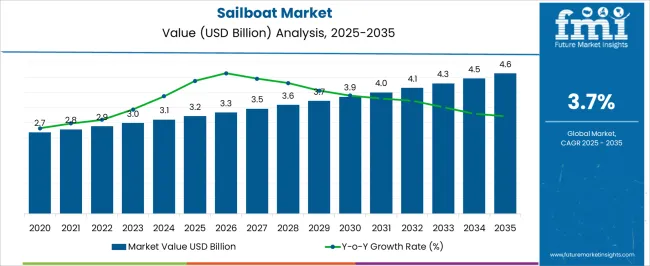
| Metric | Value |
|---|---|
| Sailboat Market Estimated Value in (2025 E) | USD 3.2 billion |
| Sailboat Market Forecast Value in (2035 F) | USD 4.6 billion |
| Forecast CAGR (2025 to 2035) | 3.7% |
The sailboat market is witnessing steady growth, supported by increasing consumer interest in recreational sailing, rising disposable income, and advancements in lightweight composite materials. The market is being shaped by growing participation in marine leisure activities and coastal tourism, particularly in North America and Europe.
Rising focus on fuel efficiency, silent cruising, and reduced maintenance has accelerated interest in sail-powered vessels over traditional motorboats. Boat manufacturers are investing in smart navigation systems, compact onboard utilities, and hybrid propulsion options to appeal to both new and seasoned sailors.
Regulatory support for eco-friendly marine transport and the development of marinas and sailing clubs are further contributing to market expansion. Future growth is expected to benefit from sailing sports events, charter tourism demand, and increased interest in semi-customized vessels for long-distance cruising and leisure exploration.
The sailboat market is segmented by hull type, length, propulsion, and geographic region. By hull type, the market is divided into monohull and multihull. By length, it is classified into up to 20 ft, 20 ft to 50 ft, and above 50 ft. Based on propulsion, the market is segmented into fixed pitch, variable pitch, and folding. Regionally, the sailboat industry is classified into North America, Latin America, Western Europe, Eastern Europe, Balkan & Baltic countries, Russia & Belarus, Central Asia, East Asia, South Asia & Pacific, and the Middle East & Africa.
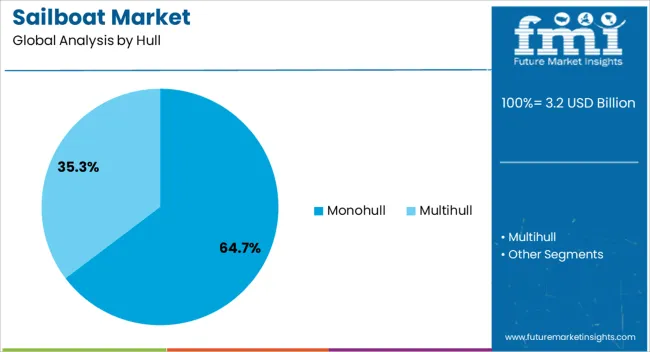
Monohull sailboats are projected to account for 64.70% of the total market share in 2025, making them the dominant hull type. This leadership is attributed to their simple design, cost-effectiveness, and better upwind performance compared to multihull alternatives.
Their popularity among individual sailors, training schools, and charter operators stems from easier maneuverability and widespread familiarity. Manufacturers have enhanced structural integrity through reinforced composites and hydrodynamic keel designs, increasing comfort and stability in offshore conditions.
The ability to accommodate various interior layouts in a streamlined hull makes monohulls adaptable for both leisure and competitive applications, which has cemented their market dominance.
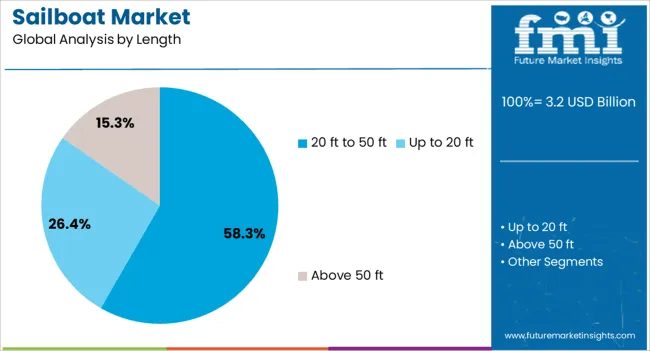
Sailboats within the 20 ft to 50 ft length range are expected to contribute 58.30% of the total market revenue in 2025, making them the leading size category. This range strikes a balance between performance, space, and affordability, appealing to both amateur sailors and seasoned cruisers.
Boats in this category are ideal for coastal and offshore navigation, with sufficient space for small groups and long-weekend voyages. Increased adoption of lightweight rigging systems and modular interiors has made this size segment more attractive for multi-purpose use.
The operational ease and docking compatibility of mid-sized sailboats make them highly preferred by rental fleets and sailing schools, further driving their market share.
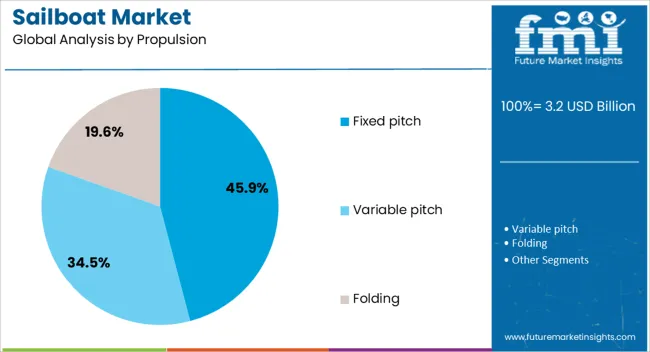
Fixed pitch propulsion systems are projected to hold 45.90% of the market share in 2025, making them the most widely used propulsion type in the sailboat segment. Their mechanical simplicity, reliability, and low maintenance requirements have made them a preferred choice for most production sailboats.
The system’s efficiency under both sail and engine power modes ensures optimal performance for varied sailing conditions. Compatibility with standard inboard diesel configurations and long service life are additional factors contributing to their adoption.
With increased focus on cost-effective and user-friendly propulsion solutions for recreational use, fixed pitch propellers continue to maintain their market lead despite the emergence of variable and electric propulsion alternatives.
The sailboat market is experiencing growth driven by increasing interest in recreational boating, sailing competitions, and eco-friendly marine transportation. Sailboats are valued for their environmentally friendly operation and appeal to both enthusiasts and competitive sailors. The rising popularity of sailing tourism, coupled with advancements in sailboat design and materials, is boosting the market. Despite challenges like high initial investment costs and maintenance requirements, there are opportunities for growth in emerging markets, particularly in regions with expanding coastal tourism industries and a growing middle class.
A significant driver for the growth of the sailboat market is the increasing interest in eco-friendly recreational activities. Sailboats, powered by wind energy, offer a sustainable alternative to fuel-powered vessels, making them an attractive option for environmentally conscious consumers. The rising popularity of sailing as a leisure activity and sport, particularly in coastal areas and tourist destinations, is also contributing to market growth. There is growing participation in sailing competitions and regattas, which further fuels the demand for high-performance sailboats. As more people seek sustainable and enjoyable outdoor experiences, the demand for sailboats continues to increase, expanding the market for both recreational and competitive sailing.
One of the key challenges in the sailboat market is the high initial investment required to purchase and maintain a sailboat. Sailboats, especially those designed for racing or long-distance cruising, can be expensive, which limits their accessibility to a broader consumer base. The maintenance of sailboats can be costly, as they require regular upkeep of sails, rigging, hulls, and mechanical systems to ensure optimal performance. The need for specialized knowledge and experience to maintain and operate sailboats also limits their appeal to novice sailors, particularly in emerging markets where sailing as a recreational activity is still developing. These challenges contribute to slower adoption rates, especially in price-sensitive regions.
The growth of sailing tourism presents significant opportunities for the sailboat market. As more consumers seek unique and eco-friendly travel experiences, sailing vacations are becoming increasingly popular, particularly in coastal regions with established sailing routes. This has led to an increase in demand for charter sailboats and private sailing vessels. Furthermore, as middle-class populations in emerging markets, such as Asia-Pacific and Latin America, grow and urbanize, the demand for recreational boating, including sailboats, is expected to rise. Manufacturers have the opportunity to cater to this expanding market by offering affordable, high-quality sailboats designed for both leisure and competition. Additionally, the development of sailing infrastructure in emerging regions presents opportunities for further market penetration.
Technological advancements are playing a key role in shaping the sailboat market. Manufacturers are increasingly focusing on innovations in sailboat design and materials to improve performance, durability, and fuel efficiency. The use of lightweight, high-strength materials such as carbon fiber and advanced composites is becoming more common, allowing for faster and more maneuverable sailboats. In addition, modern sailboats are incorporating advanced navigation systems, automated rigging, and energy-efficient systems, further enhancing their appeal to both competitive sailors and recreational enthusiasts. As consumer preferences shift toward high-performance, eco-friendly, and technologically advanced vessels, these trends are driving the evolution of the sailboat market, creating more options for consumers worldwide.
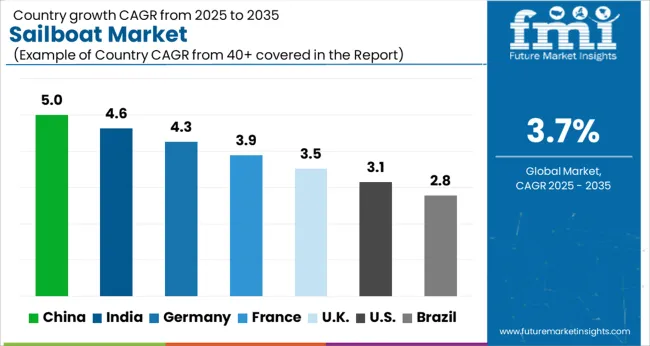
The sailboat market is set to witness steady growth at a global CAGR of 3.7% from 2025 to 2035. China leads with a CAGR of 5.0%, followed by India at 4.6%, and Germany at 4.3%. The United Kingdom records a growth rate of 3.5%, while the United States stands at 3.1%. The growth is driven by increasing demand for recreational boating, rising disposable incomes, and expanding tourism activities in coastal areas. The growing interest in sustainable boating solutions further contributes to market expansion globally. The analysis covers 40+ countries, with the leading markets shown below.
India is projected to grow at a CAGR of 4.6% through 2035, driven by the increasing demand for recreational sailing and boating activities, as well as growing tourism in coastal areas. The rise in disposable incomes and a shift towards leisure boating in India is contributing to the growth of the sailboat market. Additionally, India's vast coastline and increasing interest in water sports further boost the demand for sailboats. The expanding middle class, along with an increase in domestic production of sailboats, strengthens the market outlook. Government initiatives to promote coastal tourism also aid market growth.
China is projected to grow at a CAGR of 5.0% through 2035, driven by the rising demand for leisure boating and the country’s growing interest in water sports. The expansion of the leisure and tourism industries in coastal regions has increased the demand for sailboats in China. Additionally, the growing number of sailing enthusiasts and the rise in disposable income contribute to market growth. China's increasing manufacturing capabilities in boating products also support market expansion. Moreover, China’s government is promoting water tourism, which further strengthens the market for sailboats, both for personal use and for commercial purposes.
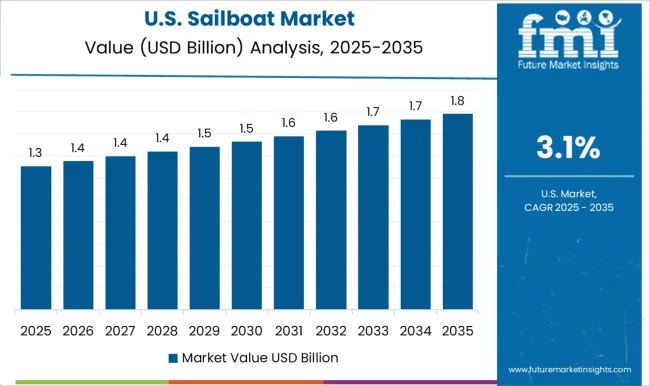
The United States is projected to grow at a CAGR of 3.1% through 2035, with demand driven by the increasing popularity of recreational boating and water sports activities. The USA has a well-established sailboat market, with a significant demand for high-end and specialized sailboats used in both leisure and competitive sailing. The market is also supported by growing disposable incomes, increasing tourism, and the expanding interest in environmentally friendly and energy-efficient boats. Government incentives and environmental regulations encouraging sustainable boating practices further contribute to the market’s growth.
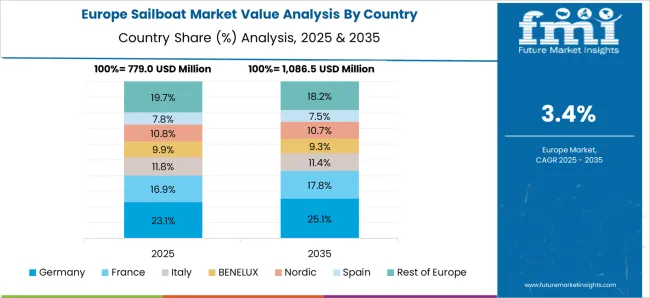
Germany is projected to grow at a CAGR of 4.3% through 2035, driven by its established position as a leader in boating technology and manufacturing. The demand for sailboats in Germany is supported by the country’s strong interest in water sports, leisure sailing, and competitive sailing events. Furthermore, Germany’s extensive waterways and tourism infrastructure contribute to the growth of the sailboat market. The increasing focus on sustainable and eco-friendly boating technologies in the region is another key factor influencing the adoption of sailboats. Additionally, Germany’s highly developed marine equipment and manufacturing sectors contribute to market growth.
The United Kingdom is projected to grow at a CAGR of 3.5% through 2035, supported by the country’s well-established maritime culture and strong demand for recreational boating. The UK has an extensive coastline, which encourages the adoption of sailboats, particularly for leisure and competitive sailing events. Additionally, the rising interest in sustainable and energy-efficient boating solutions contributes to the market growth. The UK’s strong boating tourism sector and its growing number of sailing clubs further bolster demand. The country’s government is also supporting water-based leisure activities, contributing to the continued expansion of the market.
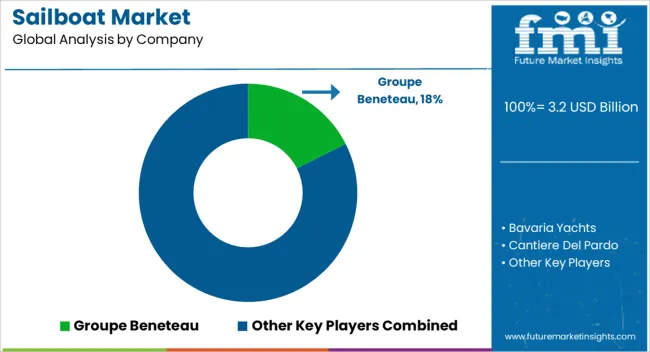
The sailboat market is driven by renowned manufacturers that specialize in luxury, performance, and recreational sailboats. Groupe Beneteau and Bavaria Yachts are key leaders, offering a diverse range of sailboats from performance-oriented models to luxury cruising yachts, catering to both novice and experienced sailors. Cantiere Del Pardo focuses on producing high-performance sailboats known for their design and innovation in the racing and cruising segments.
Najad and Nautor Swan are highly regarded for their elegant, custom-built sailing yachts, catering to a more exclusive market seeking high-end performance and style. Oyster Yachts is a prominent player in the luxury yacht market, offering performance and luxury for blue water cruising. These manufacturers differentiate themselves through their unique design, advanced engineering, and emphasis on comfort, performance, and craftsmanship.
| Item | Value |
|---|---|
| Quantitative Units | USD Billion |
| Hull | Monohull and Multihull |
| Length | 20 ft to 50 ft, Up to 20 ft, and Above 50 ft |
| Propulsion | Fixed pitch, Variable pitch, and Folding |
| Regions Covered | North America, Europe, Asia-Pacific, Latin America, Middle East & Africa |
| Country Covered | United States, Canada, Germany, France, United Kingdom, China, Japan, India, Brazil, South Africa |
| Key Companies Profiled | Groupe Beneteau, Bavaria Yachts, Cantiere Del Pardo, Catalina Yachts, Fountaine Pajot, Hallberg-Rassy Varvs, HanseYachts, Najad, Nautor Swan, and Oyster Yachts |
| Additional Attributes | Dollar sales by boat type (monohulls, catamarans) and end-use segments (luxury yachts, cruising yachts, performance sailboats). Demand dynamics are driven by increasing interest in leisure sailing, rising disposable incomes in key markets, and growing consumer preference for luxury and high-performance vessels. Regional trends show strong growth in North America and Europe, with emerging demand in Asia-Pacific driven by rising interest in recreational boating. |
The global sailboat market is estimated to be valued at USD 3.2 billion in 2025.
The market size for the sailboat market is projected to reach USD 4.6 billion by 2035.
The sailboat market is expected to grow at a 3.7% CAGR between 2025 and 2035.
The key product types in sailboat market are monohull and multihull.
In terms of length, 20 ft to 50 ft segment to command 58.3% share in the sailboat market in 2025.






Our Research Products

The "Full Research Suite" delivers actionable market intel, deep dives on markets or technologies, so clients act faster, cut risk, and unlock growth.

The Leaderboard benchmarks and ranks top vendors, classifying them as Established Leaders, Leading Challengers, or Disruptors & Challengers.

Locates where complements amplify value and substitutes erode it, forecasting net impact by horizon

We deliver granular, decision-grade intel: market sizing, 5-year forecasts, pricing, adoption, usage, revenue, and operational KPIs—plus competitor tracking, regulation, and value chains—across 60 countries broadly.

Spot the shifts before they hit your P&L. We track inflection points, adoption curves, pricing moves, and ecosystem plays to show where demand is heading, why it is changing, and what to do next across high-growth markets and disruptive tech

Real-time reads of user behavior. We track shifting priorities, perceptions of today’s and next-gen services, and provider experience, then pace how fast tech moves from trial to adoption, blending buyer, consumer, and channel inputs with social signals (#WhySwitch, #UX).

Partner with our analyst team to build a custom report designed around your business priorities. From analysing market trends to assessing competitors or crafting bespoke datasets, we tailor insights to your needs.
Supplier Intelligence
Discovery & Profiling
Capacity & Footprint
Performance & Risk
Compliance & Governance
Commercial Readiness
Who Supplies Whom
Scorecards & Shortlists
Playbooks & Docs
Category Intelligence
Definition & Scope
Demand & Use Cases
Cost Drivers
Market Structure
Supply Chain Map
Trade & Policy
Operating Norms
Deliverables
Buyer Intelligence
Account Basics
Spend & Scope
Procurement Model
Vendor Requirements
Terms & Policies
Entry Strategy
Pain Points & Triggers
Outputs
Pricing Analysis
Benchmarks
Trends
Should-Cost
Indexation
Landed Cost
Commercial Terms
Deliverables
Brand Analysis
Positioning & Value Prop
Share & Presence
Customer Evidence
Go-to-Market
Digital & Reputation
Compliance & Trust
KPIs & Gaps
Outputs
Full Research Suite comprises of:
Market outlook & trends analysis
Interviews & case studies
Strategic recommendations
Vendor profiles & capabilities analysis
5-year forecasts
8 regions and 60+ country-level data splits
Market segment data splits
12 months of continuous data updates
DELIVERED AS:
PDF EXCEL ONLINE

Thank you!
You will receive an email from our Business Development Manager. Please be sure to check your SPAM/JUNK folder too.
Chat With
MaRIA